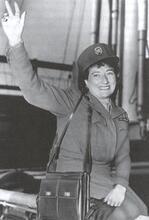Ruth Gruber
Ruth Gruber graduated from New York University at eighteen and travelled to Germany to study, where at age twenty, she became the youngest PhD in the world. She returned to the United States, where she became the first foreign correspondent allowed to travel to the Soviet Arctic and witness Stalin’s gulags. In 1944, Gruber was made a simulated US general to escort European refugees to America. Deeply moved by the stories of the refugees, she recorded them in her book Haven. In the years leading up to Israel’s independence, Gruber visited concentration camps and profiled David Ben-Gurion and other Israeli leaders. She covered the crisis of the Exodus 1947 as it unfolded, and her book became the basis for Leon Uris’s novel and the award-winning movie. In 1985, she helped rescue Ethiopian Jews and recorded their stories.
Early Life and Education
Ruth Gruber moved across most of the twentieth century as a compassionate writer, eloquent speaker, humanitarian, and rescuer of Jews.
Gruber was born on September 30, 1911, in Brooklyn, the fourth of five children of David and Gussie (Rockower) Gruber, Russian Jewish immigrants who owned a wholesale and retail liquor store and later went into real estate. She graduated from New York University at age eighteen and in 1930 won a fellowship to the University of Wisconsin, where she received her MA in German and English literature. In 1931, Gruber received a fellowship from the Institute of International Education for study in Cologne, Germany. Her parents pleaded with her not to go: Hitler was coming to power. Nevertheless, she went to Cologne and took courses in German philosophy, modern English literature, and art history. She also attended Nazi rallies, her American passport in her purse, a tiny American flag on her lapel. She listened, appalled, as Hitler ranted hysterically against Americans and even more hysterically against Jews.
Gruber’s professors asked her to stay in Cologne and study for a PhD. Analyzing the writings of Virginia Woolf, she received her doctorate magna cum laude in one year. The New York Times reported that, at age twenty, she was the youngest PhD in the world.
Early Journalism Career and Work with the Government
Gruber returned home in the midst of the Great Depression and, like most of her peers, was unable to find a job, so she began writing. After many rejections of her work, she wrote an article about Brooklyn, describing its colorful neighborhoods as a microcosm of Europe, which the New York Times bought for the Sunday paper. Then Gruber began sending stories to the New York Herald Tribune, and with their acceptance felt she had found her home.
In 1935, she won another fellowship, given at the recommendation of the Guggenheim Foundation, to write a study of women under fascism, communism, and democracy. The Herald Tribune gave her press credentials, and she became the first foreign correspondent, male or female, allowed to fly through Siberia into the Soviet Arctic. She lived among pioneers and prisoners, many of them Jews, in the gulag in Stalin’s iron age.
In 1941, Secretary of the Interior Harold L. Ickes, after reading her book I Went to the Soviet Arctic, sent Gruber as his field representative to make a social and economic study of Alaska in connection with opening it for GIs and homesteaders. For over eighteen months she covered the vast territory by plane, train, truck, paddle-wheel steamer, and dogsled. On Gruber’s return to Washington, Ickes appointed her his special assistant. She worked for him five years.
In 1944, while war and the Holocaust raged, President Roosevelt decided to bring a thousand refugees from Europe to Fort Ontario, a former army camp in Oswego, a small town in upper New York State. Gruber was selected by Ickes to fly to Europe on a secret mission to escort the refugees to America. Ickes told her, “You’re going to be given the rank of simulated general,” and he explained: “If you’re shot down and the Nazis capture you as a civilian, they can kill you as a spy. But as a general, according to the Geneva Convention, they have to give you food and shelter and keep you alive.”
Escorting the refugees by ship from Naples, Italy, Gruber recorded their stories of how they had survived. Often, she had to stop writing because tears were wiping out the words in her notebook. Soon the refugees began calling her “Mother Ruth.” The voyage became the defining Jewish moment of her life. She knew that from then on, her life would be inextricably bound with rescuing Jews in danger.
Gruber’s book about the experience, Haven: The Unknown Story of 1,000 World War II Refugees, became the basis for the permanent Holocaust exhibit in the State Museum in Albany called “From Holocaust to Haven.” On Sunday, October 6, 2002, she helped dedicate the Safe Haven Museum in Oswego, NY. In her honor the museum library is called The Dr. Ruth Gruber Library and Resource Center.
In 2001, Haven was made into a four-hour television miniseries by Columbia Broadcasting System. The actress Natasha Richardson played Ruth, and Anne Bancroft received an Emmy nomination for her role as Ruth’s mother.
Israel Reporting and Exodus 1947
In 1946, the war over, Gruber left the government and returned to journalism. The New York Post asked her to cover the Anglo-American Committee of Inquiry on Palestine. For four months, she traveled with the committee to the death camps and the displaced persons camps in Germany, then she went on to Palestine, where she became a trusted friend of the founding fathers and mothers of the State of Israel. Her profiles of David Ben-Gurion, who was then almost unknown in the United States, made American readers aware of his prophetic character and unswerving Lincoln-like determination to build a Jewish state.
The next year, Gruber returned to the New York Herald Tribune as a foreign correspondent and traveled with the United Nations Special Committee on Palestine through Europe and the Middle East. In Jerusalem, she learned that a ship called Exodus 1947, with forty-five hundred survivors of the Holocaust aboard, was battling the British in the Mediterranean. Gruber decided to cover the Exodus.
In Haifa, surrounded by tanks and barbed wire, Gruber watched as British soldiers carried down the battered bodies of Bill Bernstein, the beloved American second mate, and two sixteen-year-old orphans. Some of the refugees came down dejectedly; those who refused were pulled down. All were transferred to three prison ships, Runnymede Park, Ocean Vigour, and Empire Rival. The British told her they were being sent to the island of Cyprus, where in three years from 1945 to 1948 fifty-two thousand survivors of the Holocaust were imprisoned. She flew to Cyprus to wait for the ships, but they never came. Instead, they were returned to Port de Bouc, near Marseilles, the port from which they had sailed. After three weeks, the British announced they were sending the Jews of the Exodus back to Germany. They selected Gruber as the pool correspondent to represent the American press. Her photos of the agony inside the Runnymede Park were sent by the Herald Tribune around the world, and her photo of the swastika painted on the British Union Jack became Life magazine’s Picture of the Week. Her book, Exodus 1947: The Ship that Launched a Nation, provided source material for the book and movie Exodus and for numerous TV documentaries.
Later Reporting and Personal Life
In 1951, Gruber married Philip H. Michaels, a lawyer, vice president of the Sachs Quality Stores, and a member of the New York City Youth Board. In 1952, at age forty-one, she gave birth to her first child, Celia; her son, David, was born in 1954. Gruber continued working as a special foreign correspondent for the Herald Tribune, covering every major wave of immigrants into Israel until the paper’s demise in 1966. At the same time, she also wrote a popular column for Hadassah Magazine, “Diary of an American Housewife,” and, as a volunteer, served as associate chair of the Greater New York Women’s Division of United Jewish Appeal, where she wrote and directed the scripts for their many performances. In 1991, she became honorary chair of the Israel Bonds Golda Meir Club.
Michaels died in 1968, and six years later Gruber married Henry Rosner, then deputy commissioner of the New York City Department of Human Resources. He accompanied her to Israel, where she spent nearly a year writing her best-known biography, Raquela: A Woman of Israel, which won the National Jewish Book Award for Best Book on Israel in 1979. In 1982, Henry Rosner died.
In 1985, Gruber traveled to the isolated Jewish villages in the highlands of Ethiopia to aid in the rescue of the Ethiopian Jews. Her book Rescue: The Exodus of the Ethiopian Jews was acclaimed by critics and such leaders as Menachem Begin, Abba Eban, and Elie Wiesel. The recipient of many awards, in 1995 Gruber was given Na’amat USA’s Golda Meir Human Rights Award for her life’s work. That same year, for Na’mat Woman magazine, she covered the United Nations Fourth World Conference on Women in Beijing. In 1997, she won several prestigious awards from the Simon Wiesenthal Center’s Museum of Tolerance for her lifelong work rescuing Jews. In 1998, Gruber received a Lifetime Achievement Award from her peers in the American Society of Journalists and Authors as “a pioneering journalist and author whose books chronicle the most important events of the twentieth century.” In 2010, the Norman Mailer Center awarded Gruber a special Distinguished Journalism Prize.
Gruber received five honorary doctorates including University of Wisconsin, University of New York (SUNY) Oswego and Hebrew Union College.
In 2001, at the age of ninety, she completed a twenty-city tour to publicize the reprinting of four of her books. When asked the secret of her success, Ruth Gruber replied, “Have dreams, have visions and let no obstacle stop you.”
Gruber passed away on November 17, 2016, at the age of 105.
Selected Works by Ruth Gruber
Inside of Time: My Journey from Alaska to Israel: A Memoir with Eleanor Roosevelt, Harold L. Ickes, Golda Meir, and Other Friends (2003). It received a Pulitzer nomination.
Ahead of Time: My Early Years as a Foreign Correspondent (1991).
Destination Palestine: The Story of the Haganah Ship Exodus 1947 (1948). Republished in a revised edition as Exodus 1947: The Ship that Launched a Nation (1999).
Felisa Rincon de Gautier: The Mayor of San Juan (1972).
Haven: The Unknown Story of 1,000 World War II Refugees (1983).
I Can Tell It Now: Members of the Overseas Press Club (1960).
Israel on the Seventh Day (1968).
Israel Today: Land of Many Nations (1958).
Israel Without Tears (1950).
Puerto Rico: Island of Promise (1960).
Raquela: A Woman of Israel (1978).
Rescue: The Exodus of the Ethiopian Jews (1987).
Science and the New Nations (1961).
They Came to Stay (1976).
Virginia Woolf: A Study (1934).
Virginia Woolf: The Will to Create as a Woman (2005)
I Went to the Soviet Arctic (1939).
Witness: One of the Great Correspondents of the Twentieth Century Tells Her Story (2007)
Sources for this biography include Ruth Gruber’s books, magazine articles, lectures, and appearances in films and documentaries, including The Great Depression for PBS, Truman for PBS, Exiles and Emigrants for Los Angeles County Museum of Art, Exodus 1947, and the 1997 Oscar Award Documentary The Long Way Home, her biography on the website “Miriam’s Cup,” as well as interviews and conversations with the author.





